Ultrafast Laser Processing for High-Aspect-Ratio Structures
Abstract
:1. Introduction
2. The Multiphoton Absorption and Threshold Effect in Ultrafast Laser Processing
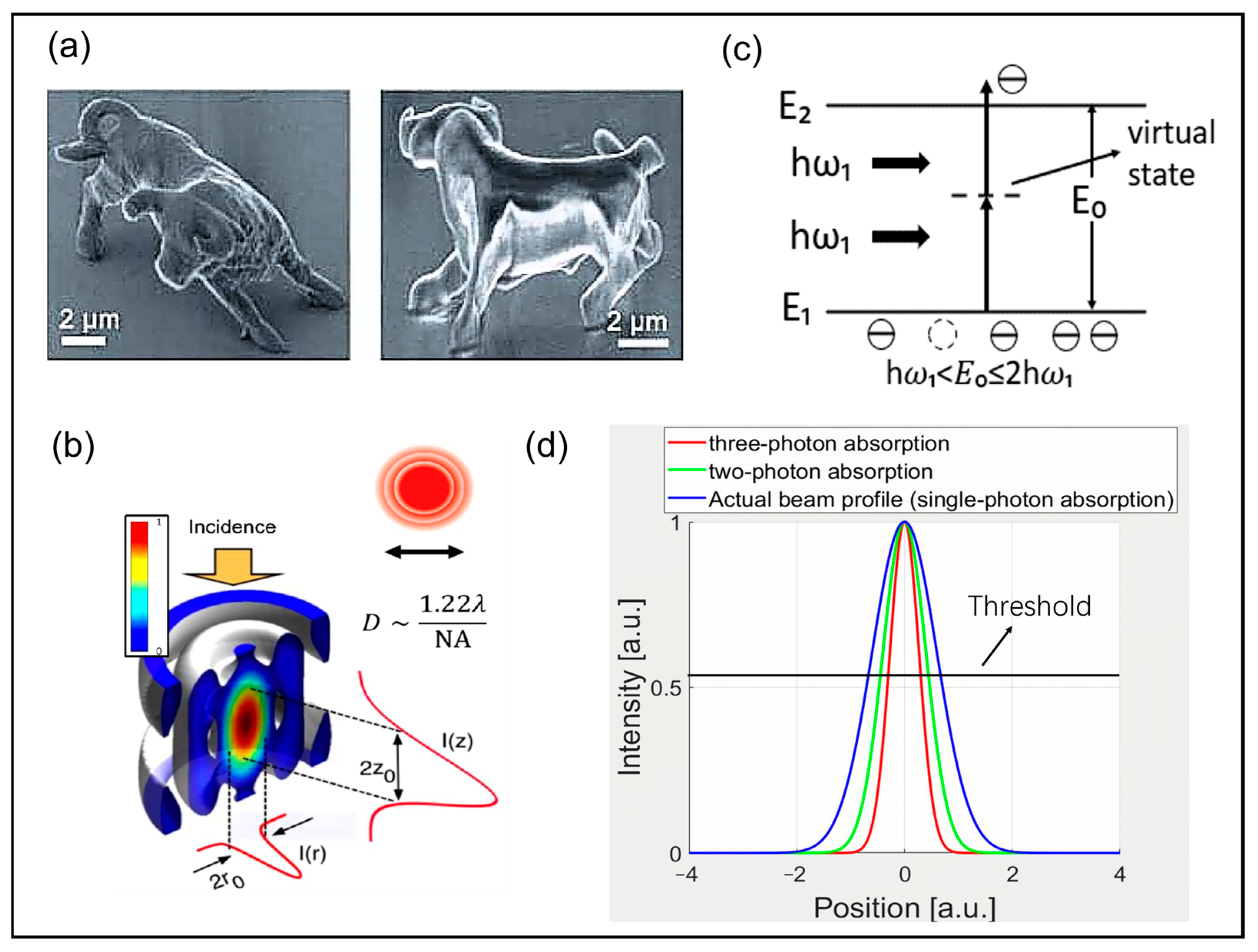
3. Filamentation Processing
4. Bessel Beam Processing
5. Conclusions and Outlook
Author Contributions
Funding
Conflicts of Interest
References
- Srinivasan, R.; Sutcliffe, E.; Braren, B. Ablation and Etching of Polymethylmethacrylate by Very Short (160 Fs) Ultraviolet (308 Nm) Laser Pulses. Appl. Phys. Lett. 1987, 51, 1285–1287. [Google Scholar] [CrossRef]
- Tan, D.; Sharafudeen, K.N.; Yue, Y.; Qiu, J. Femtosecond Laser Induced Phenomena in Transparent Solid Materials: Fundamentals and Applications. Prog. Mater. Sci. 2016, 76, 154–228. [Google Scholar] [CrossRef]
- Kerse, C.; Kalaycioglu, H.; Elahi, P.; Çetin, B.; Kesim, D.K.; Akçaalan, Ö.; Yavas, S.; Asik, M.D.; Öktem, B.; Hoogland, H.; et al. Ablation-Cooled Material Removal with Ultrafast Bursts of Pulses. Nature 2016, 537, 84–88. [Google Scholar] [CrossRef]
- Zhou, N.; Yuan, S.M.; Gao, M.X.; Zhang, W.; Zhang, J.Q.; Hu, T.R. Investigations on the Oxidation Behavior and Removal Mechanism of Sic/Sic Composites by Multi-Pulse Femtosecond Laser Ablation. J. Mater. Res. Technol. 2023, 26, 3408–3425. [Google Scholar] [CrossRef]
- Leitz, K.H.; Redlingshöfer, B.; Reg, Y.; Otto, A.; Schmidt, M. Metal Ablation with Short and Ultrashort Laser Pulses. Phys. Procedia 2011, 12, 230–238. [Google Scholar] [CrossRef]
- Sugioka, K.; Cheng, Y. Femtosecond Laser Three-Dimensional Micro- and Nanofabrication. Appl. Phys. Rev. 2014, 1, 041303. [Google Scholar] [CrossRef]
- Duocastella, M.; Arnold, C.B. Bessel and Annular Beams for Materials Processing. Laser Photonics Rev. 2012, 6, 607–621. [Google Scholar] [CrossRef]
- Olson, R.W.; Swope, W.C. Laser Drilling with Focused Gaussian Beams. J. Appl. Phys. 1992, 72, 3686–3696. [Google Scholar] [CrossRef]
- Uchtmann, H.; He, C.; Gillner, A. High Precision and High Aspect Ratio Laser Drilling—Challenges and Solutions. In Proceedings of the 2016 SPIE LASE, San Francisco, CA, USA, 16–18 February 2016; Volume 9741, p. 974106. [Google Scholar]
- Huang, H.; Yang, L.M.; Liu, J. Micro-Hole Drilling and Cutting Using Femtosecond Fiber Laser. Opt. Eng. 2014, 53, 051513. [Google Scholar] [CrossRef]
- Jedrkiewicz, O.; Kumar, S.; Sotillo, B.; Bollani, M.; Chiappini, A.; Ferrari, M.; Ramponi, R.; Di Trapani, P.; Eaton, S.M. High Precision and High Aspect Ratio Laser Drilling—Challenges and Solutions Surface for Versatile Microfluidic and Sensing Applications. Opt. Mater. Express 2017, 7, 1962–1970. [Google Scholar] [CrossRef]
- Zeng, C.; Tian, W.; Hua, L. A Comprehensive Study of Thermal Damage Consequent to Laser Surface Treatment. Mater. Sci. Eng. A 2013, 564, 381–388. [Google Scholar] [CrossRef]
- Bhar, G.C.; Chaudhary, A.K.; Kumbhakar, P. Study of Laser Induced Damage Threshold and Effect of Inclusions in Some Nonlinear Crystals. Appl. Surf. Sci. 2000, 161, 155–162. [Google Scholar] [CrossRef]
- Joglekar, A.P.; Liu, H.; Spooner, G.J.; Meyhöfer, E.; Mourou, G.; Hunt, A.J. A Study of the Deterministic Character of Optical Damage by Femtosecond Laser Pulses and Applications to Nanomachining. Appl. Phys. B 2003, 77, 25–30. [Google Scholar] [CrossRef]
- Le Harzic, R.; Huot, N.; Audouard, E.; Jonin, C.; Laporte, P.; Valette, S.; Fraczkiewicz, A.; Fortunier, R. Comparison of Heat Affected Zone Due to Nanosecond and Femtosecond Laser Pulses Using Transmission Electronic Microscopy. Appl. Phys. Lett. 2002, 80, 3886–3888. [Google Scholar] [CrossRef]
- Nedialkov, N.N.; Imamova, S.E.; Atanasov, P.A. Ablation of Metals by Ultrashort Laser Pulses. J. Phys. D Appl. Phys. 2004, 37, 638. [Google Scholar] [CrossRef]
- Kondo, T.; Yamasaki, K.; Juodkazis, S.; Matsuo, S.; Mizeikis, V.; Misawa, H. Three-Dimensional Microfabrication by Femtosecond Pulses in Dielectrics. Thin Solid Films 2004, 453–454, 550–556. [Google Scholar] [CrossRef]
- Cao, X.W.; Chen, Q.D.; Fan, H.; Zhang, L.; Juodkazis, S.; Sun, H.B. Liquid-Assisted Femtosecond Laser Precision-Machining of Silica. Nanomaterials 2018, 8, 287. [Google Scholar] [CrossRef]
- Macernyte, L.; Skruibis, J.; Vaicaitis, V.; Sirutkaitis, R.; Balachninaite, O. Femtosecond Laser Micromachining of Soda-Lime Glass in Ambient Air and under Various Aqueous Solutions. Micromachines 2019, 10, 354. [Google Scholar] [CrossRef]
- Sundaram, S.K.; Mazur, E. Inducing and Probing Non-Thermal Transitions in Semiconductors Using Femtosecond Laser Pulses. Nat. Mater. 2002, 1, 217–224. [Google Scholar] [CrossRef]
- Gattass, R.; Mazur, E. Femtosecond Laser Micromachining in Transparent Materials. Nat. Photonics 2008, 2, 219–225. [Google Scholar] [CrossRef]
- Yokoshi, N.; Ishihara, H. Giant Multiphoton Absorption in Silicon. Nat. Photonics 2018, 12, 125–126. [Google Scholar] [CrossRef]
- Du, D.; Liu, X.; Korn, G.; Squier, J.; Mourou, G. Laser-Induced Breakdown by Impact Ionization in Sio2 with Pulse Widths from 7 Ns to 150 Fs. Appl. Phys. Lett. 1994, 64, 3071–3073. [Google Scholar] [CrossRef]
- Suzuura, H.; Ando, T. Phonons and Electron-Phonon Scattering in Carbon Nanotubes. Phys. Rev. B 2002, 65, 235412. [Google Scholar] [CrossRef]
- Liu, X.; Du, D.; Mourou, G. Laser Ablation and Micromachining with Ultrashort Laser Pulses. IEEE J. Quantum Electron. 1997, 33, 1706–1716. [Google Scholar] [CrossRef]
- Tanaka, T.; Sun, H.-B.; Kawata, S. Rapid Sub-Diffraction-Limit Laser Micro/Nanoprocessing in a Threshold Material System. Appl. Phys. Lett. 2002, 80, 312–314. [Google Scholar] [CrossRef]
- Wood, R.M.; Taylor, R.T.; Rouse, R.L. Laser Damage in Optical Materials at 1.06 Μm. Opt. Laser Technol. 1975, 7, 105–111. [Google Scholar] [CrossRef]
- Lin, Z.Y.; Liu, K.; Cao, T.; Hong, M.H. Microsphere Femtosecond Laser Sub-50 Nm Structuring in Far Field Via Non-Linear Absorption. Optoelectron. Adv. 2023, 6, 230029. [Google Scholar] [CrossRef]
- Glezer, E.N.; Milosavljevic, M.; Huang, L.; Finlay, R.J.; Her, T.H.; Callan, J.P.; Mazur, E. Three-Dimensional Optical Storage inside Transparent Materials. Opt. Lett. 1996, 21, 2023–2025. [Google Scholar] [CrossRef]
- Takada, K.; Sun, H.B.; Kawata, S. Improved Spatial Resolution and Surface Roughness in Photopolymerization-Based Laser Nanowriting. Appl. Phys. Lett. 2005, 86, 071122. [Google Scholar] [CrossRef]
- Itoh, K.; Watanabe, W.; Nolte, S.; Schaffer, C.B. Ultrafast Processes for Bulk Modification of Transparent Materials. MRS Bull. 2006, 31, 620–625. [Google Scholar] [CrossRef]
- Liao, Y.; Zeng, B.; Qiao, L.; Liu, L.; Sugioka, K.; Cheng, Y. Threshold Effect in Femtosecond Laser Induced Nanograting Formation in Glass: Influence of the Pulse Duration. Appl. Phys. A 2014, 114, 223–230. [Google Scholar] [CrossRef]
- Chen, T.Q.; Zhang, G.D.; Wang, Y.S.; Li, X.L.; Stoian, R.; Cheng, G.H. Reconstructing of Embedded High-Aspect-Ratio Nano-Voids Generated by Ultrafast Laser Bessel Beams. Micromachines 2020, 11, 671. [Google Scholar] [CrossRef]
- Liu, X.; Clady, R.; Grojo, D.; Utéza, O.; Sanner, N. Engraving Depth-Controlled Nanohole Arrays on Fused Silica by Direct Short-Pulse Laser Ablation. Adv. Mater. Interfaces 2023, 10, 2202189. [Google Scholar] [CrossRef]
- Hercher, M. Laser-Induced Damage in Transparent Media. J. Opt. Soc. Am. 2009, 54, 563. [Google Scholar]
- Yao, Z.L.; Jiang, L.; Li, X.W.; Wang, A.D.; Wang, Z.; Li, M.; Lu, Y.F. Non-Diffraction-Length, Tunable, Bessel-Like Beams Generation by Spatially Shaping a Femtosecond Laser Beam for High-Aspect-Ratio Micro-Hole Drilling. Opt. Express 2018, 26, 21960–21968. [Google Scholar] [CrossRef]
- Rapp, L.; Meyer, R.; Giust, R.; Furfaro, L.; Jacquot, M.; Lacourt, P.A.; Dudley, J.M.; Courvoisier, F. High Aspect Ratio Micro-Explosions in the Bulk of Sapphire Generated by Femtosecond Bessel Beams. Sci. Rep. 2016, 6, 34286. [Google Scholar] [CrossRef]
- Velpula, P.K.; Bhuyan, M.K.; Courvoisier, F.; Zhang, H.; Colombier, J.P.; Stoian, R. Spatio-Temporal Dynamics in Nondiffractive Bessel Ultrafast Laser Nanoscale Volume Structuring. Laser Photonics Rev. 2016, 10, 230–244. [Google Scholar] [CrossRef]
- Kiselev, D.; Woeste, L.; Wolf, J.P. Filament-Induced Laser Machining (Film). Appl. Phys. B 2010, 100, 515–520. [Google Scholar] [CrossRef]
- Braun, A.; Korn, G.; Liu, X.; Du, D.; Squier, J.; Mourou, G. Self-Channeling of High-Peak-Power Femtosecond Laser Pulses in Air. Opt. Lett. 1995, 20, 73–75. [Google Scholar] [CrossRef]
- Ivanov, N.G.; Losev, V.F. Kerr Nonlinearity Effect on Femtosecond Pulse Radiation Filamentation in Air. Atmos. Ocean. Opt. 2017, 30, 331–336. [Google Scholar] [CrossRef]
- Feit, M.D.; Fleck, J.A., Jr. Effect of Refraction on Spot-Size Dependence of Laser-Induced Breakdown. Appl. Phys. Lett. 1974, 24, 169–172. [Google Scholar] [CrossRef]
- Dharmadhikari, J.A.; Deshpande, R.A.; Nath, A.; Dota, K.; Mathur, D.; Dharmadhikari, A.K. Effect of Group Velocity Dispersion on Supercontinuum Generation and Filamentation in Transparent Solids. Appl. Phys. B 2014, 117, 471–479. [Google Scholar] [CrossRef]
- Vaičaitis, V.; Butkus, R.; Balachninaitė, O.; Morgner, U.; Babushkin, I. Diffraction-Enhanced Femtosecond White-Light Filaments in Air. Appl. Phys. B 2018, 124, 221. [Google Scholar] [CrossRef]
- Rothenberg, J.E. Space—Time Focusing: Breakdown of the Slowly Varying Envelope Approximation in the Self-Focusing of Femtosecond Pulses. Opt. Lett. 1992, 17, 1340. [Google Scholar] [CrossRef] [PubMed]
- Théberge, F.; Liu, W.; Simard, P.T.; Becker, A.; Chin, S.L. Plasma Density inside a Femtosecond Laser Filament in Air: Strong Dependence on External Focusing. Phys. Rev. E Stat. Nonlin. Soft Matter Phys. 2006, 74, 036406. [Google Scholar] [CrossRef]
- Nibbering, E.T.; Curley, P.F.; Grillon, G.; Prade, B.S.; Franco, M.A.; Salin, F.; Mysyrowicz, A. Conical Emission from Self-Guided Femtosecond Pulses in Air. Opt. Lett. 1996, 21, 62–65. [Google Scholar] [CrossRef]
- Kasparian, J.; Sauerbrey, R.; Chin, S.L. The Critical Laser Intensity of Self-Guided Light Filaments in Air. Appl. Phys. B 2000, 71, 877–879. [Google Scholar] [CrossRef]
- Anguiano-Morales, M. Self-Healing Properties of Asymmetric Bessel Beams. Opt. Quantum Electron. 2018, 50, 363. [Google Scholar] [CrossRef]
- Čižmár, T.; Dholakia, K. Tunable Bessel Light Modes: Engineering the Axial Propagation. Opt. Express 2009, 17, 15558–15570. [Google Scholar] [CrossRef]
- Tan, J.; Yu, R.; Xiao, L. Bessel-Like Beams Generated Via Fiber-Based Polymer Microtips. Opt. Lett. 2019, 44, 1007–1010. [Google Scholar] [CrossRef]
- Stoian, R.; Bhuyan, M.K.; Zhang, G.; Cheng, G.; Meyer, R.; Courvoisier, F. Ultrafast Bessel Beams: Advanced Tools for Laser Materials Processing. Adv. Opt. Technol. 2018, 7, 165–174. [Google Scholar] [CrossRef]
- Zhao, L.; Wang, F.; Jiang, L.; Lu, Y.; Zhao, W.; Xie, J.; Li, X. Femtosecond Bessel-Beam-Assisted High-Aspect-Ratio Microgroove Fabrication in Fused Silica. Chin. Opt. Lett. 2015, 13, 041405. [Google Scholar] [CrossRef]
- Hendricks, F.; Au, J.A.D.; Matylitsky, V.V. High Aspect Ratio Microstructuring of Transparent Dielectrics Using Femtosecond Laser Pulses: Method for Optimization of the Machining Throughput. Appl. Phys. A. 2014, 117, 149–153. [Google Scholar] [CrossRef]
- Courvoisier, F.; Stoian, R.; Couairon, A. Ultrafast Laser Micro- and Nano-Processing with Nondiffracting and Curved Beams: Invited Paper for the Section: Hot Topics in Ultrafast Lasers. Opt. Laser Technol. 2016, 80, 125–137. [Google Scholar] [CrossRef]
- Zhang, Y.; Lowe, R.M.; Harvey, E.; Hannaford, P.; Endo, A. High Aspect-Ratio Micromachining of Polymers with an Ultrafast Laser. Appl. Surf. Sci. 2002, 186, 345–351. [Google Scholar] [CrossRef]
- Liu, H.G.; Li, Y.; Lin, W.X.; Hong, M.H. High-Aspect-Ratio Crack-Free Microstructures Fabrication on Sapphire by Femtosecond Laser Ablation. Opt. Laser Technol. 2020, 132, 106472. [Google Scholar] [CrossRef]
- Lee, S.; Park, B.; Kim, J.S.; Kim, T.-I. Designs and Processes toward High-Aspect-Ratio Nanostructures at the Deep Nanoscale: Unconventional Nanolithography and Its Applications. Nanotechnology 2016, 27, 474001. [Google Scholar] [CrossRef]
- Martínez-Herrero, R.; Carnicer, A.; Juvells, I.; Sanz, A.S. Uncertainty Principle for Axial Power Content of Highly Focused Fields. Opt. Express 2020, 28, 29676–29690. [Google Scholar] [CrossRef]
- Kagoshima, Y.; Takayama, Y. Inverse-Phase Composite Zone Plate Providing Deeper Focus Than the Normal Diffraction-Limited Depth of X-Ray Microbeams. J. Synchrotron Radiat. 2019, 26, 52–58. [Google Scholar] [CrossRef]
- Birk, U.; Hase Jv Cremer, C. Super-Resolution Microscopy with Very Large Working Distance by Means of Distributed Aperture Illumination. Sci. Rep. 2017, 7, 3685. [Google Scholar] [CrossRef]
- Kononenko, V.V.; Konov, V.I. Fs Laser Induced Reversible and Irreversible Processes in Transparent Bulk Material; Springer International Publishing: Cham, Switzerland, 2014; pp. 247–268. [Google Scholar]
- Joglekar, A.P.; Liu, H.-H.; Meyhöfer, E.; Mourou, G.; Hunt, A.J. Optics at Critical Intensity: Applications to Nanomorphing. Proc. Natl. Acad. Sci. USA 2004, 101, 5856–5861. [Google Scholar] [CrossRef] [PubMed]
- Kylstra, N.J.; Joachain, C.J.; Dörr, M. Theory of Multiphoton Ionization of Atoms; Springer: Boston, MA, USA, 2001; pp. 15–36. [Google Scholar]
- Mark, T.D. Fundamental Aspects of Electron Impact Ionization. Int. J. Mass Spectrom. Ion Phys. 1982, 45, 125–145. [Google Scholar] [CrossRef]
- Pronko, P.P.; VanRompay, P.A.; Horvath, C.; Loesel, F.; Juhasz, T.; Liu, X.; Mourou, G. Avalanche Ionization and Dielectric Breakdown in Silicon with Ultrafast Laser Pulses. Phys. Rev. B 1998, 58, 2387–2390. [Google Scholar] [CrossRef]
- Wellershoff, S.S.; Hohlfeld, J.; Güdde, J.; Matthias, E. The Role of Electron–Phonon Coupling in Femtosecond Laser Damage of Metals. Appl. Phys. A 1999, 69, S99–S107. [Google Scholar]
- Kawata, S.; Sun, H.-B.; Tanaka, T.; Takada, K. Finer Features for Functional Microdevices. Nature 2001, 412, 697–698. [Google Scholar] [CrossRef] [PubMed]
- Malinauskas, M.; Farsari, M.; Piskarskas, A.; Juodkazis, S. Ultrafast Laser Nanostructuring of Photopolymers: A Decade of Advances. Phys. Rep. 2013, 533, 1–31. [Google Scholar] [CrossRef]
- Küper, S.; Stuke, M. Femtosecond Uv Excimer Laser Ablation. Appl. Phys. B 1987, 44, 199–204. [Google Scholar] [CrossRef]
- Hacker, E.; Lauth, H.; Weissbrodt, P. Review of Structural Influences on the Laser Damage Thresholds of Oxide Coatings. SPIE 1996, 2714, 316–330. [Google Scholar]
- Glezer, E.; Huang, L.; Finlay, R.; Her, T.-H.; Callan, J.; Schaffer, C.; Mazur, E. Ultrafast Laser-Induced Microexplosions in Transparent Materials. SPIE 1997, 2966, 392–403. [Google Scholar]
- Sugioka, K.; Cheng, Y. A Tutorial on Optics for Ultrafast Laser Materials Processing: Basic Microprocessing System to Beam Shaping and Advanced Focusing Methods. Adv. Opt. Technol. 2012, 1, 353–364. [Google Scholar] [CrossRef]
- Sugioka, K.; Cheng, Y. Ultrafast Lasers-Reliable Tools for Advanced Materials Processing. Light Sci. Appl. 2014, 3, 149. [Google Scholar] [CrossRef]
- Sopeña, P.; Garcia-Lechuga, M.; Wang, A.; Grojo, D. Ultrafast Laser Stabilization by Nonlinear Absorption for Enhanced-Precision Material Processing. Opt. Lett. 2022, 47, 993–996. [Google Scholar] [CrossRef]
- Garcia-Lechuga, M.; Gebrayel El Reaidy, G.; Ning, H.; Delaporte, P.; Grojo, D. Assessing the Limits of Determinism and Precision in Ultrafast Laser Ablation. Appl. Phys. Lett. 2020, 117, 171604. [Google Scholar] [CrossRef]
- Askaryan, G.A. Effect of the Gradient of a Strong Electromagnetic Ray on Electrons and Atoms. Sov. Phys. JETP 1962, 15, 1088–1090. [Google Scholar]
- Brodeur, A.; Chien, C.Y.; Ilkov, F.A.; Chin, S.L.; Kosareva, O.G.; Kandidov, V.P. Moving Focus in the Propagation of Ultrashort Laser Pulses in Air. Opt. Lett. 1997, 22, 304–306. [Google Scholar] [CrossRef]
- Tzortzakis, S.; Papazoglou, D.G.; Zergioti, I. Long-Range Filamentary Propagation of Subpicosecond Ultraviolet Laser Pulses in Fused Silica. Opt. Lett. 2006, 31, 796–798. [Google Scholar] [CrossRef] [PubMed]
- Yan, T.; Ji, L. Ultrafast Laser Filamentation in Transparent Solids. Ultrafast Sci. 2023, 3, 0023. [Google Scholar] [CrossRef]
- Kasparian, J.; Wolf, J.P. Physics and Applications of Atmospheric Nonlinear Optics and Filamentation. Opt. Express 2008, 16, 466–493. [Google Scholar] [CrossRef]
- Tochitsky, S.; Welch, E.; Polyanskiy, M.; Pogorelsky, I.; Panagiotopoulos, P.; Kolesik, M.; Wright, E.M.; Koch, S.W.; Moloney, J.V.; Pigeon, J.; et al. Megafilament in Air Formed by Self-Guided Terawatt Long-Wavelength Infrared Laser. Nat. Photonics 2019, 13, 41–46. [Google Scholar] [CrossRef]
- Mahmoud Aghdami, K.; Rahnama, A.; Ertorer, E.; Herman, P.R. Laser Nano-Filament Explosion for Enabling Open-Grating Sensing in Optical Fibre. Nat. Commun. 2021, 12, 6344. [Google Scholar] [CrossRef]
- Tokarev, V.N.; Melnikov, I.V. A Strategy for Achieving Smooth Filamentation Cutting of Transparent Materials with Ultrafast Lasers. Appl. Sci. 2021, 11, 1732. [Google Scholar] [CrossRef]
- Talebpour, A.; Abdel-Fattah, M.; Chin, S.L. Focusing Limits of Intense Ultrafast Laser Pulses in a High Pressure Gas: Road to New Spectroscopic Source. Opt. Commun. 2000, 183, 479–484. [Google Scholar] [CrossRef]
- Qi, P.; Qian, W.; Guo, L.; Xue, J.; Zhang, N.; Wang, Y.; Zhang, Z.; Zhang, Z.; Lin, L.; Sun, C.; et al. Sensing with Femtosecond Laser Filamentation. Sensors 2022, 22, 7076. [Google Scholar] [CrossRef] [PubMed]
- Courvoisier, F. Ultrafast Laser Micro-Nano Structuring of Transparent Materials with High Aspect Ratio. In Handbook of Laser Micro- and Nano-Engineering; Sugioka, K., Ed.; Springer International Publishing: Cham, Switzerland, 2020; pp. 1–37. [Google Scholar]
- Couairon, A.; Mysyrowicz, A. Femtosecond Filamentation in Transparent Media. Phys. Rep. 2007, 441, 47–189. [Google Scholar] [CrossRef]
- Marburger, J.H. Self-Focusing: Theory. Prog. Quantum Electron. 1975, 4, 35–110. [Google Scholar] [CrossRef]
- Luo, L.; Wang, D.L.; Li, C.D.; Jiang, H.B.; Yang, H.; Gong, Q.H. Formation of Diversiform Microstructures in Wide-Bandgap Materials by Tight-Focusing Femtosecond Laser Pulses. J. Opt. A Pure Appl. Opt. 2002, 4, 105–110. [Google Scholar] [CrossRef]
- Sun, X.; Zeng, T.; Gao, H.; Zhang, S.; Liu, W. Power Dependent Filamentation of a Femtosecond Laser Pulse in Air by Focusing with an Axicon. J. Phys. B At. Mol. Opt. Phys. 2015, 48, 094004. [Google Scholar] [CrossRef]
- Ahmed, F.; Shamim Ahsan, M.; Seop Lee, M.; Jun, M.B.G. Near-Field Modification of Femtosecond Laser Beam to Enhance Single-Shot Pulse Filamentation in Glass Medium. Appl. Phys. A 2014, 114, 1161–1165. [Google Scholar] [CrossRef]
- Xia, B.; Jiang, L.; Li, X.W.; Yan, X.L.; Zhao, W.W.; Lu, Y.F. High Aspect Ratio, High-Quality Microholes in Pmma: A Comparison between Femtosecond Laser Drilling in Air and in Vacuum. Appl. Phys. A. 2015, 119, 61–68. [Google Scholar] [CrossRef]
- Bhuyan, M.K.; Courvoisier, F.; Lacourt, P.A.; Jacquot, M.; Furfaro, L.; Withford, M.J.; Dudley, J.M. High Aspect Ratio Taper-Free Microchannel Fabrication Using Femtosecond Bessel Beams. Opt. Express 2010, 18, 566–574. [Google Scholar] [CrossRef]
- Amina; Ji, L.; Yan, T.; Wang, Y.; Li, L. Characteristics of 1064 Nm Picosecond Laser Induced Filamentary Tracks and Damages in Sapphire. Opt. Laser Technol. 2019, 116, 232–238. [CrossRef]
- Xu, X.; He, J.; He, J.; Xu, B.; Chen, R.; Wang, Y.; Yang, Y.; Wang, Y. Efficient Point-by-Point Bragg Grating Inscription in Sapphire Fiber Using Femtosecond Laser Filaments. Opt. Lett. 2021, 46, 2742–2745. [Google Scholar] [CrossRef] [PubMed]
- Liu, B.; Yan, Y.J.; Zhao, J.; Wang, W.J.; Liao, K. Research on Hole Depth in Femtosecond Laser Deep Micropore Processing Technology Based on Filament Effect. Optik 2022, 249, 168307. [Google Scholar] [CrossRef]
- Ren, G.; Ito, Y.; Sun, H.; Sugita, N. Temporal-Spatial Characteristics of Filament Induced by a Femtosecond Laser Pulse in Transparent Dielectrics. Opt. Express 2022, 30, 4954–4964. [Google Scholar] [CrossRef]
- Wang, J.J.; Guo, Y.J.; Song, X.W.; Lin, J.Q. Flexible Manipulation of the Onset and Terminal Positions of Femtosecond Laser Filamentation in Fused Silica Via Controlling Beam Profile before Axicon. Opt. Commun. 2022, 516, 128262. [Google Scholar] [CrossRef]
- Wang, J.; Guo, Y.; Song, X.; Guo, K.; Lin, J. Multi-Dimensional Control of Femtosecond Laser Filaments by Inserting a Wedge Plate in the Forced Focusing Region. Phys. Plasma 2022, 29, 012301. [Google Scholar] [CrossRef]
- Vitek, D.N.; Adams, D.E.; Johnson, A.; Tsai, P.S.; Backus, S.; Durfee, C.G.; Kleinfeld, D.; Squier, J.A. Temporally Focused Femtosecond Laser Pulses for Low Numerical Aperture Micromachining through Optically Transparent Materials. Opt. Express 2010, 18, 18086–18094. [Google Scholar] [CrossRef]
- Lapointe, J.; Kashyap, R. A Simple Technique to Overcome Self-Focusing, Filamentation, Supercontinuum Generation, Aberrations, Depth Dependence and Waveguide Interface Roughness Using Fs Laser Processing. Sci. Rep. 2017, 7, 499. [Google Scholar] [CrossRef]
- Durnin, J. Exact Solutions for Nondiffracting Beams. I. The Scalar Theory. J. Opt. Soc. Am. A 1987, 4, 651–654. [Google Scholar] [CrossRef]
- Marcinkevičius, A.; Juodkazis, S.; Matsuo, S.; Mizeikis, V.; Misawa, H. Application of Bessel Beams for Microfabrication of Dielectrics by Femtosecond Laser. Jpn. J. Appl. Phys. 2001, 40, L1197. [Google Scholar] [CrossRef]
- Bhuyan, M.K.; Courvoisier, F.; Lacourt, P.A.; Jacquot, M.; Salut, R.; Furfaro, L.; Dudley, J.M. High Aspect Ratio Nanochannel Machining Using Single Shot Femtosecond Bessel Beams. Appl. Phys. Lett. 2010, 97, 081102. [Google Scholar] [CrossRef]
- Mitra, S.; Chanal, M.; Clady, R.; Mouskeftaras, A.; Grojo, D. Millijoule Femtosecond Micro-Bessel Beams for Ultra-High Aspect Ratio Machining. Appl. Opt. 2015, 54, 7358–7365. [Google Scholar] [CrossRef]
- Lu, Y.; Kai, L.; Chen, C.; Qing, Y.; Meng, Y.; Liu, Y.; Cheng, Y.; Hou, X.; Chen, F. Nanochannels with a 18-Nm Feature Size and Ultrahigh Aspect Ratio on Silica through Surface Assisting Material Ejection. Adv. Photonics Nexus 2022, 1, 026004. [Google Scholar] [CrossRef]
- Lu, Z.; Guo, Z.; Fan, M.; Guo, M.; Li, C.; Yao, Y.; Zhang, H.; Lin, W.; Liu, H.; Liu, B. Tunable Bessel Beam Shaping for Robust Atmospheric Optical Communication. J. Lightwave Technol. 2022, 40, 5097–5106. [Google Scholar] [CrossRef]
- Qin, F.; Huang, K.; Wu, J.; Teng, J.; Qiu, C.-W.; Hong, M. A Supercritical Lens Optical Label-Free Microscopy: Sub-Diffraction Resolution and Ultra-Long Working Distance. Adv. Mater. 2017, 29, 1602721. [Google Scholar] [CrossRef]
- Courvoisier, F.; Bhuyan, M.K.; Jacquot, M.; Lacourt, P.A.; Salut, R.; Furfaro, L.; Dudley, J.M. High Aspect Ratio Taper-Free Micro and Nano-Channel Fabrication in Glass with Ultrafast Nondiffracting Bessel Beams. In Proceedings of the 2011 SPIE LASE, San Francisco, CA, USA, 22–27 January 2011; Volume 7921, p. 79210K. [Google Scholar]
- Song, Y.P.; Xu, J.; Liu, Z.X.; Zhang, A.D.; Yu, J.P.; Qi, J.; Chen, W.; Cheng, Y. Fabrication of High-Aspect-Ratio Fused Silica Microstructures with Large Depths Using Bessel-Beam Femtosecond Laser-Assisted Etching. Opt. Laser Technol. 2024, 170, 110305. [Google Scholar] [CrossRef]
- Fan, D.; Wang, L.; Ekinci, Y. Nanolithography Using Bessel Beams of Extreme Ultraviolet Wavelength. Sci. Rep. 2016, 6, 31301. [Google Scholar] [CrossRef]
- Stoian, R.; Bhuyan, M.K.; Rudenko, A.; Colombier, J.-P.; Cheng, G. High-Resolution Material Structuring Using Ultrafast Laser Non-Diffractive Beams. Adv. Phys.-X 2019, 4, 1659180. [Google Scholar] [CrossRef]
- Xie, Q.; Li, X.W.; Jiang, L.; Xia, B.; Yan, X.L.; Zhao, W.W.; Lu, Y.F. High-Aspect-Ratio, High-Quality Microdrilling by Electron Density Control Using a Femtosecond Laser Bessel Beam. Appl. Phys. A 2016, 122, 136. [Google Scholar] [CrossRef]
- Bhuyan, M.K.; Velpula, P.K.; Colombier, J.P.; Olivier, T.; Faure, N.; Stoian, R. Single-Shot High Aspect Ratio Bulk Nanostructuring of Fused Silica Using Chirp-Controlled Ultrafast Laser Bessel Beams. Appl. Phys. Lett. 2014, 104, 021107. [Google Scholar] [CrossRef]
- Mori, S. Side Lobe Suppression of a Bessel Beam for High Aspect Ratio Laser Processing. Precis. Eng. 2015, 39, 79–85. [Google Scholar] [CrossRef]
- Won, S.J.; Jeong, S. Laser Drilling of Stainless Steel Foil with Reduced Sidelobe Ablation Using a Spatially Filtered Bessel–Gauss Beam. J. Micromech. Microeng. 2022, 32, 115001. [Google Scholar] [CrossRef]
- Durnin, J.; Miceli, J.J.; Eberly, J.H. Diffraction-Free Beams. Phys. Rev. Lett. 1987, 58, 1499–1501. [Google Scholar] [CrossRef]
- Kohno, M.; Matsuoka, Y. Microfabrication and Drilling Using Diffraction-Free Pulsed Laser Beam Generated with Axicon Lens. JSME Int. J. Ser. B 2004, 47, 497–500. [Google Scholar] [CrossRef]
- Wang, H.R.; Zhang, F.; Ding, K.W.; Duan, J. Non-Diffraction-Length Bessel-Beam Femtosecond Laser Drilling of High-Aspect-Ratio Microholes in Pmma. OPTIK 2021, 229, 166295. [Google Scholar] [CrossRef]
- Müller, A.; Wapler, M.C.; Wallrabe, U. Micro-Optical System for Depth-Controlled Bessel Beam Arrays. In Proceedings of the 2019 International Conference on Optical MEMS and Nanophotonics (OMN), Daejeon, Republic of Korea, 28 July–1 August 2019; pp. 184–185. [Google Scholar]
- Muller, A.; Wapler, M.C.; Wallrabe, U. Segmented Bessel Beams. Opt. Express 2017, 25, 22640–22647. [Google Scholar] [CrossRef]
- Liu, X.; Li, Q.; Sikora, A.; Sentis, M.; Utéza, O.; Stoian, R.; Zhao, W.; Cheng, G.; Sanner, N. Truncated Gaussian-Bessel Beams for Short-Pulse Processing of Small-Aspect-Ratio Micro-Channels in Dielectrics. Opt. Express 2019, 27, 6996–7008. [Google Scholar] [CrossRef]
- Datta, S.; Clady, R.; Grojo, D.; Utéza, O.; Sanner, N. Scalable Nanophotonic Structures inside Silica Glass Laser-Machined by Intense Shaped Beams. Laser Photonics Rev. 2024; 2301365, early view. [Google Scholar]
- Ouadghiri-Idrissi, I.; Giust, R.; Froehly, L.; Jacquot, M.; Furfaro, L.; Dudley, J.M.; Courvoisier, F. Arbitrary Shaping of on-Axis Amplitude of Femtosecond Bessel Beams with a Single Phase-Only Spatial Light Modulator. Opt. Express 2016, 24, 11495–11504. [Google Scholar] [CrossRef]
- Lutz, C.; Schwarz, S.; Marx, J.; Esen, C.; Hellmann, R. Multi-Bessel Beams Generated by an Axicon and a Spatial Light Modulator for Drilling Applications. Photonics 2023, 10, 413. [Google Scholar] [CrossRef]
- Efron, U. Spatial Light Modulators for Optical Computing and Information Processing. In Proceedings of the Twenty-Second Annual Hawaii International Conference on System Sciences. Volume 1: Architecture Track, Kailua-Kona, HI, USA, 3–6 January 1989; Volume 1, pp. 416–423. [Google Scholar]
- Kong, D.; Sun, X.; Hu, Y.; Duan, J.A. Theoretical and Experimental Research on a Spatially Modulated Femtosecond Bessel-Like Laser for Microdrilling in Silica Glass. Opt. Commun. 2023, 542, 129594. [Google Scholar] [CrossRef]
- Luo, Z.; Wang, C.; Yin, K.; Dong, X.; Chu, D.; Duan, J.A. Rapid Fabrication of Cylindrical Microlens Array by Shaped Femtosecond Laser Direct Writing. Appl. Phys. A 2016, 122, 633. [Google Scholar] [CrossRef]
- Wu, M.; Jiang, L.; Li, T.; Huang, J.; Yi, P.; Zhang, L.; Li, M.; Zhang, X.; Li, X. Efficient Fabrication of Infrared Antireflective Microstructures on a Curved Diamond-Zns Composite Surface by Using Femtosecond Bessel-Like Beams. Opt. Express 2023, 31, 28670–28682. [Google Scholar] [CrossRef]
- Jenne, M.; Flamm, D.; Ouaj, T.; Hellstern, J.; Kleiner, J.; Grossmann, D.; Koschig, M.; Kaiser, M.; Kumkar, M.; Nolte, S. High-Quality Tailored-Edge Cleaving Using Aberration-Corrected Bessel-Like Beams. Opt. Lett. 2018, 43, 3164–3167. [Google Scholar] [CrossRef] [PubMed]
- Yu, X.M.; Todi, A.; Tang, H.M. Bessel Beam Generation Using a Segmented Deformable Mirror. Appl. Opt. 2018, 57, 4677–4682. [Google Scholar] [CrossRef] [PubMed]
- He, F.; Yu, J.; Tan, Y.; Chu, W.; Zhou, C.; Cheng, Y.; Sugioka, K. Tailoring Femtosecond 1.5-Μm Bessel Beams for Manufacturing High-Aspect-Ratio through-Silicon Vias. Sci. Rep. 2017, 7, 40785. [Google Scholar] [CrossRef]
- Ouadghiri-Idrissi, I.; Dudley, J.M.; Courvoisier, F. Controlling Nonlinear Instabilities in Bessel Beams through Longitudinal Intensity Shaping. Opt. Lett. 2017, 42, 3785–3788. [Google Scholar] [CrossRef] [PubMed]
- Meyer, R.; Froehly, L.; Giust, R.; Hoyo, J.; Furfaro, L.; Billet, C.; Courvoisier, F. Extremely High-Aspect-Ratio Ultrafast Bessel Beam Generation and Stealth Dicing of Multi-Millimeter Thick Glass. Appl. Phys. Lett. 2019, 114, 201105. [Google Scholar] [CrossRef]
- Zhi, Z.; Na, Q.; Xie, Q.; Chen, B.; Li, Y.; Liu, X.; Li, X.; Wang, L.; Lo, G.; Song, J. On-Chip Generation of Bessel–Gaussian Beam Via Concentrically Distributed Grating Arrays for Long-Range Sensing. Light Sci. Appl. 2023, 12, 92. [Google Scholar] [CrossRef]
- Li, Z.Q.; Allegre, O.; Li, L. Realising High Aspect Ratio 10 Nm Feature Size in Laser Materials Processing in Air at 800 Nm Wavelength in the Far-Field by Creating a High Purity Longitudinal Light Field at Focus. Light Sci. Appl. 2022, 11, 339. [Google Scholar] [CrossRef]
- Tsuru, Y.; Kozawa, Y.; Uesugi, Y.; Sato, S. Laser Nanoprocessing Via an Enhanced Longitudinal Electric Field of a Radially Polarized Beam. Opt. Lett. 2024, 49, 1405–1408. [Google Scholar] [CrossRef]
- Li, Z.-Z.; Fan, H.; Wang, L.; Zhang, X.; Zhao, X.-J.; Yu, Y.-H.; Xu, Y.-S.; Wang, Y.; Wang, X.-J.; Juodkazis, S.; et al. Super-Stealth Dicing of Transparent Solids with Nanometric Precision. Nat. Photonics 2024, 18, 799–808. [Google Scholar] [CrossRef]
- Zheng, J.-X.; Tian, K.-S.; Qi, J.-Y.; Guo, M.-R.; Liu, X.-Q. Advances in Fabrication of Micro-Optical Components by Femtosecond Laser with Etching Technology. Opt. Laser Technol. 2023, 167, 109793. [Google Scholar] [CrossRef]
- Asgari Sabet, R.; Ishraq, A.; Saltik, A.; Bütün, M.; Tokel, O. Laser Nanofabrication inside Silicon with Spatial Beam Modulation and Anisotropic Seeding. Nat. Commun. 2024, 15, 5786. [Google Scholar] [CrossRef] [PubMed]
- Žukauskas, A.; Reinhardt, C.; Chichkov, B.; Gadonas, R. Closely Packed Hexagonal Conical Microlens Array Fabricated by Direct Laser Photopolymerization. Appl. Opt. 2012, 51, 4995–5003. [Google Scholar] [CrossRef] [PubMed]
- Shaikh, S.; Kedia, S.; Majumdar, A.G.; Subramanian, M.; Sinha, S. In Vitro Bioactivity and Biocompatibility of Femtosecond Laser-Modified Ti6al4v Alloy. Appl. Phys. A 2018, 124, 821. [Google Scholar] [CrossRef]
- Zhang, Y.X.; Wu, D.; Zhang, Y.C.; Bian, Y.C.; Wang, C.W.; Li, J.W.; Chu, J.R.; Hu, Y.L. Femtosecond Laser Direct Writing of Functional Stimulus-Responsive Structures and Applications. Int. J. Extrem. Manuf. 2023, 5, 042012. [Google Scholar] [CrossRef]
- Ganguly, N.; Sopeña, P.; Grojo, D. Ultra-High-Aspect-Ratio Structures through Silicon Using Infrared Laser Pulses Focused with Axicon-Lens Doublets. Light Adv. Manuf. 2024, 5, 22. [Google Scholar] [CrossRef]
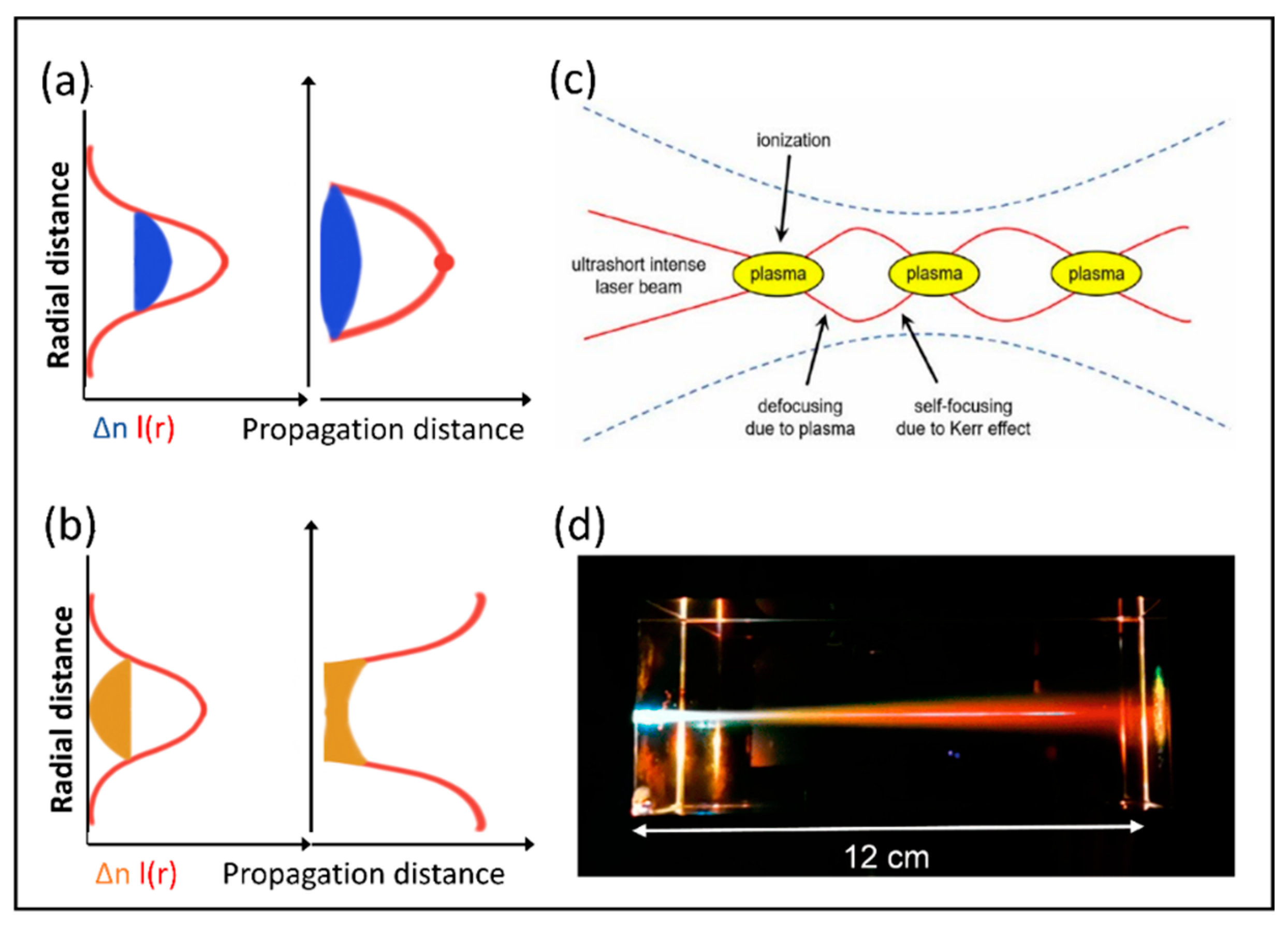
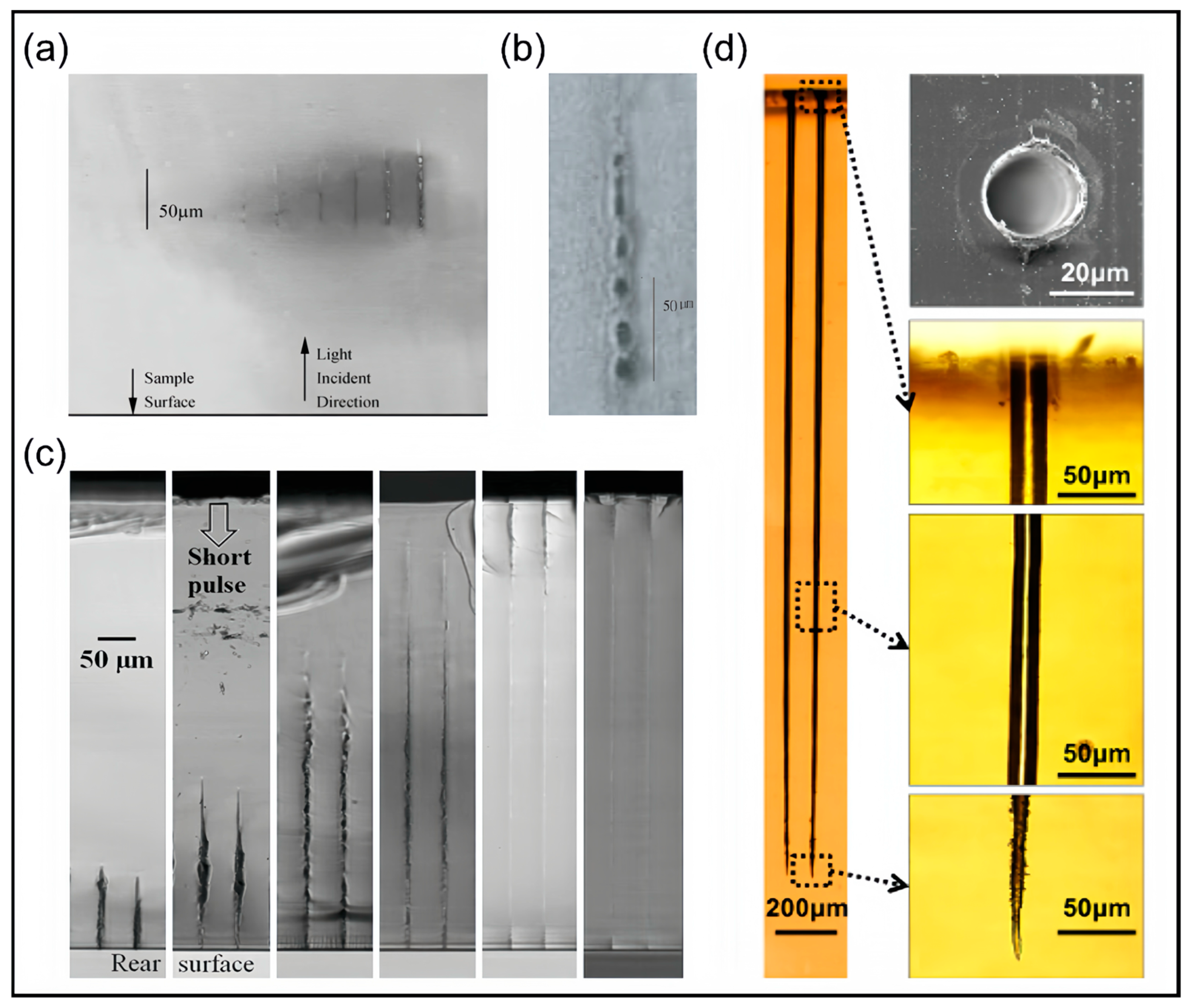
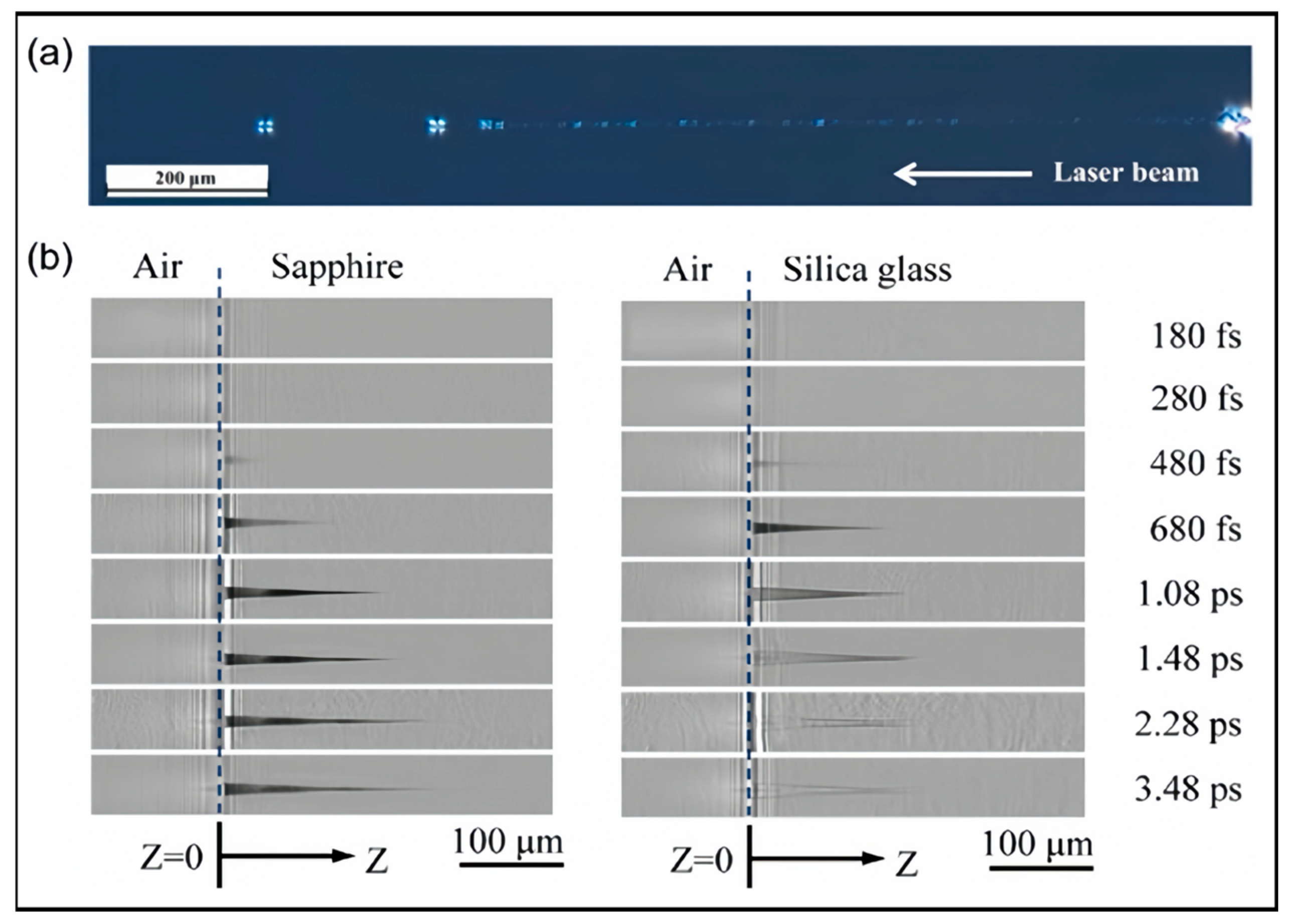

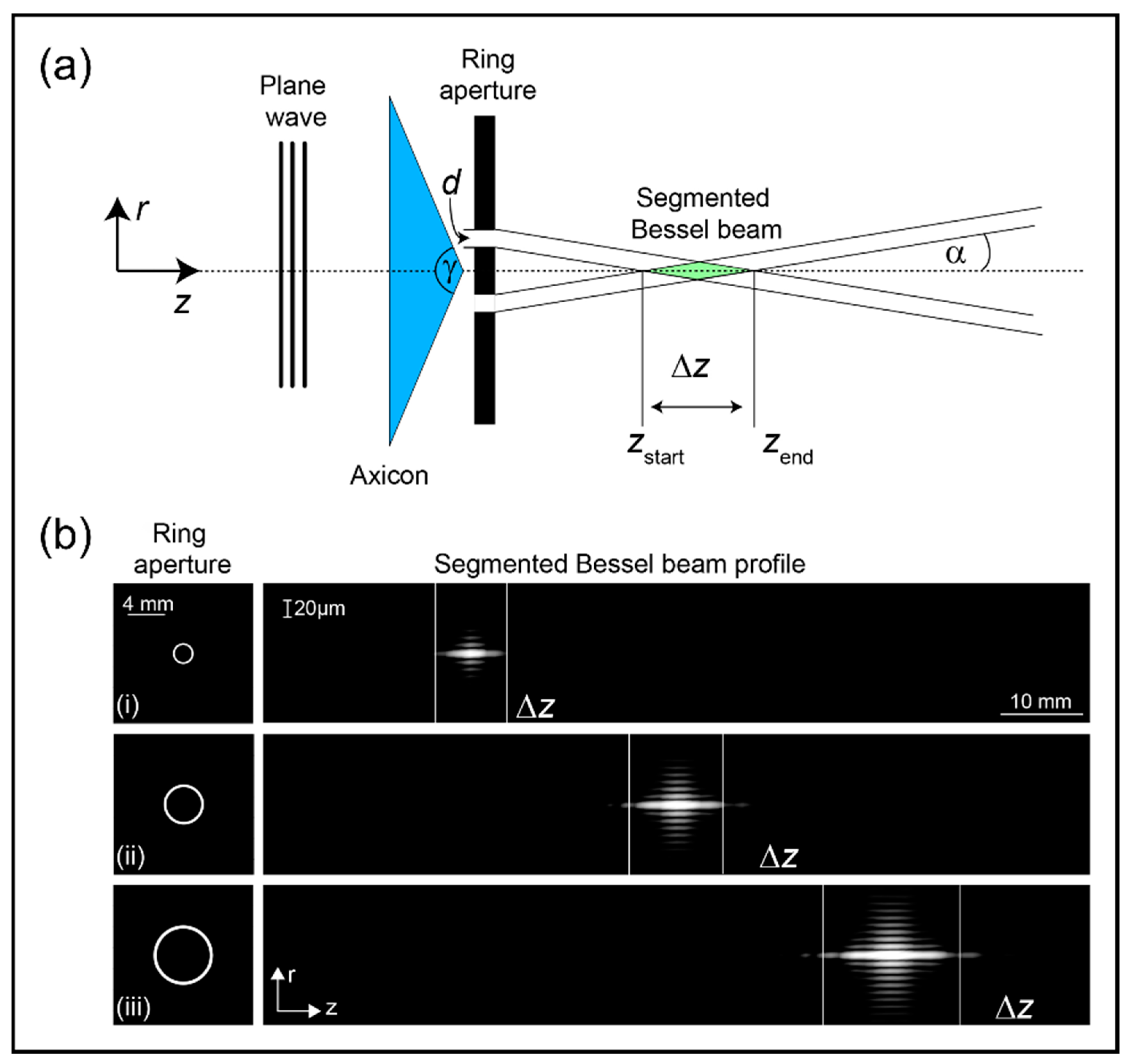

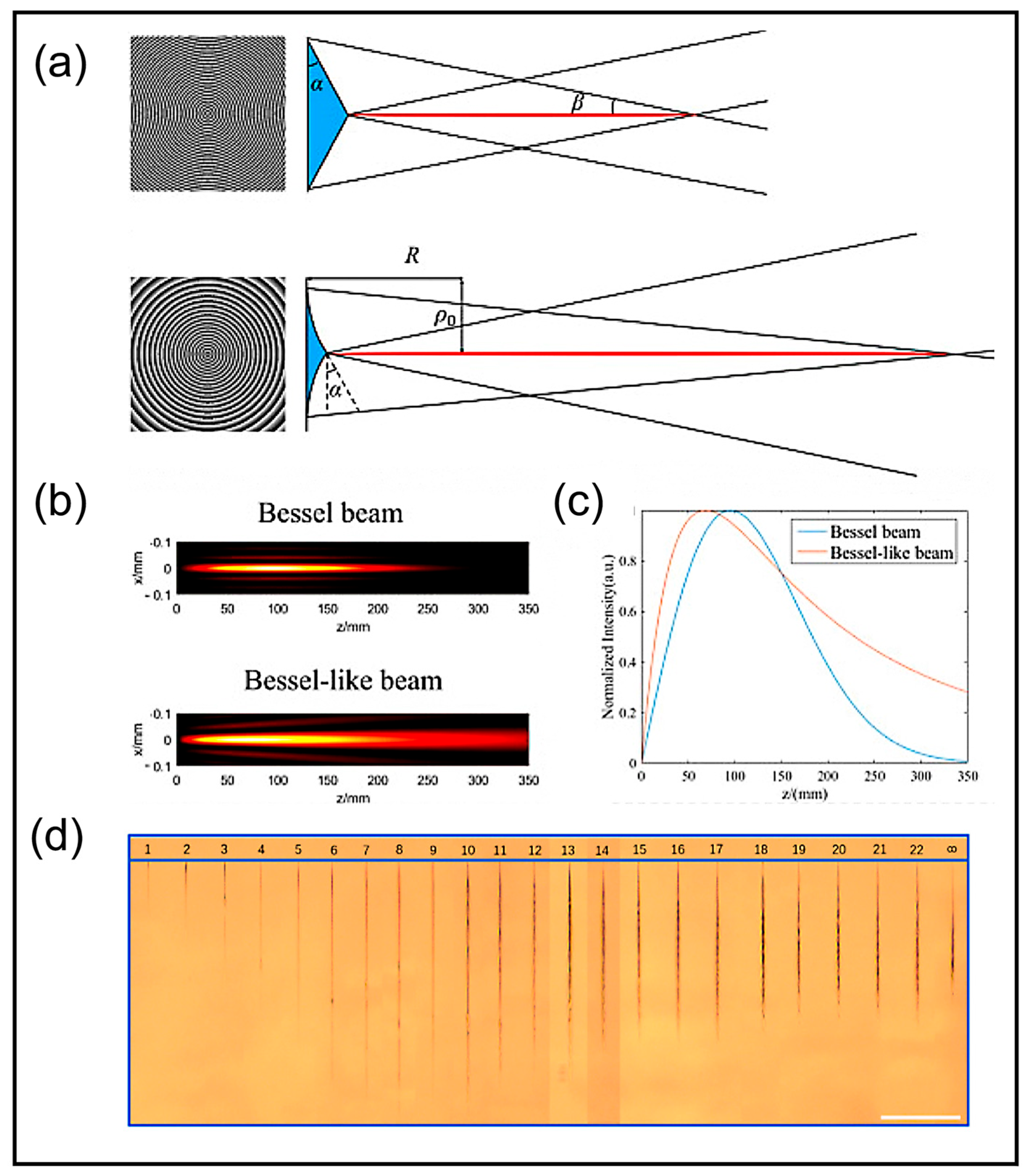
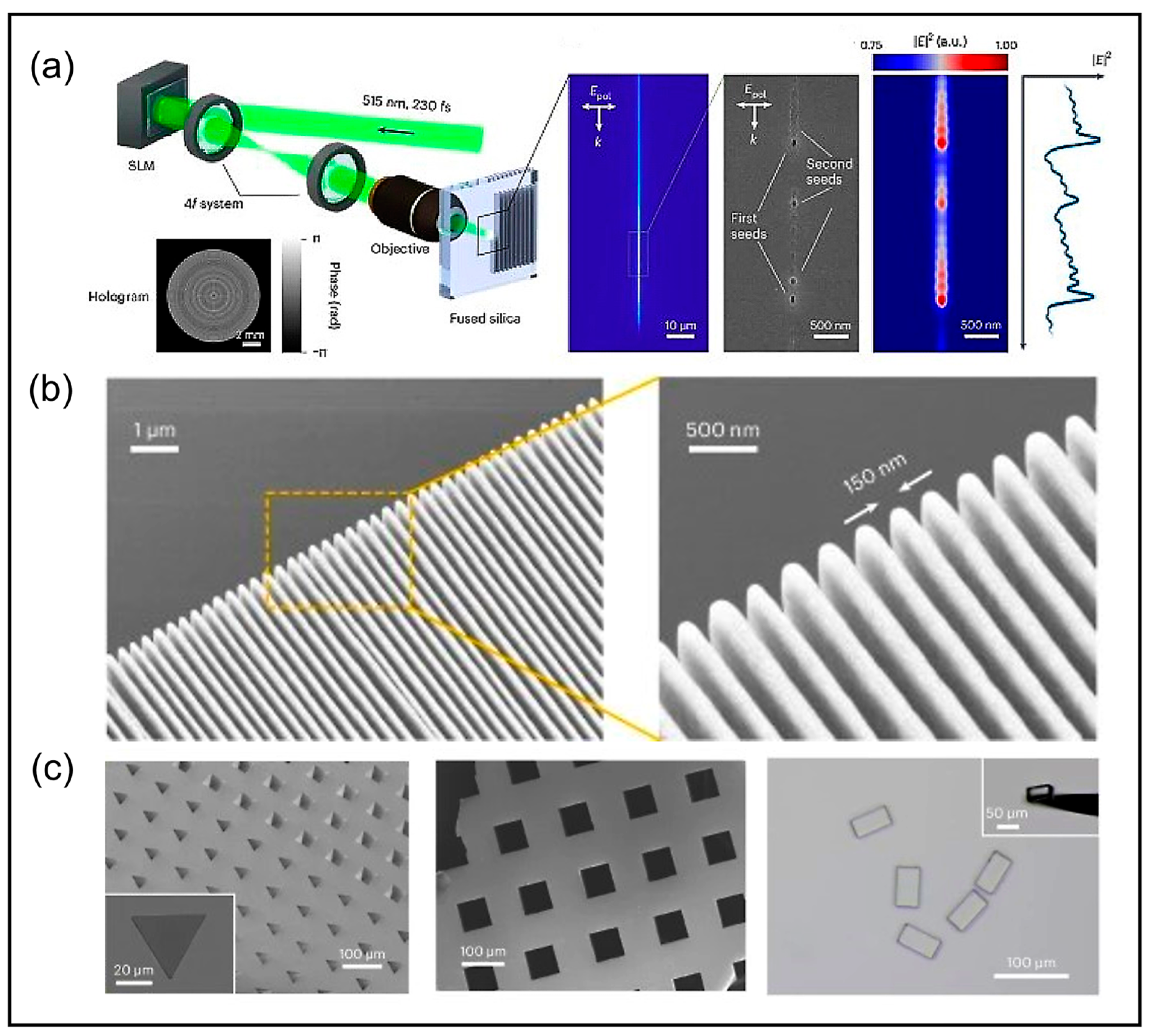
Disclaimer/Publisher’s Note: The statements, opinions and data contained in all publications are solely those of the individual author(s) and contributor(s) and not of MDPI and/or the editor(s). MDPI and/or the editor(s) disclaim responsibility for any injury to people or property resulting from any ideas, methods, instructions or products referred to in the content. |
© 2024 by the authors. Licensee MDPI, Basel, Switzerland. This article is an open access article distributed under the terms and conditions of the Creative Commons Attribution (CC BY) license (https://creativecommons.org/licenses/by/4.0/).
Share and Cite
Qin, M.; Zhao, X.; Fan, H.; Leng, R.; Yu, Y.; Li, A.; Gao, B. Ultrafast Laser Processing for High-Aspect-Ratio Structures. Nanomaterials 2024, 14, 1428. https://doi.org/10.3390/nano14171428
Qin M, Zhao X, Fan H, Leng R, Yu Y, Li A, Gao B. Ultrafast Laser Processing for High-Aspect-Ratio Structures. Nanomaterials. 2024; 14(17):1428. https://doi.org/10.3390/nano14171428
Chicago/Turabian StyleQin, Muyang, Xinjing Zhao, Hanyue Fan, Ruizhe Leng, Yanhao Yu, Aiwu Li, and Bingrong Gao. 2024. "Ultrafast Laser Processing for High-Aspect-Ratio Structures" Nanomaterials 14, no. 17: 1428. https://doi.org/10.3390/nano14171428





